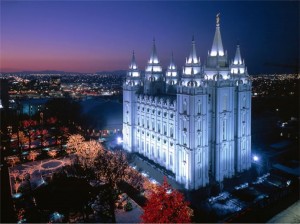Faith-based stakeholders can energize urban planning efforts
posted on Monday, January 9th, 2012 at 10:31 pmI stumbled across a podcast in Urbanophile about urban planning related to faith-based stakeholders.
This post makes the point that resiliency to recover from “place stress” can be greatly influenced by the collective religious fervor of the inhabitants. I agree. “Place stress” (my label) can be related to recovery from natural disasters, social persecution and/or the political pressure to adjust to new community pattern of living. It also suggests that faith-based constituents are likely to have an agenda that ought to be acknowledged as a stakeholder in the decision process for making physical improvements to the community.
This idea did not make much sense to me until I started thinking how the physical form of Salt Lake City was significantly influenced by the shared religious vision of its original settlers. Brigham Young, president of the Church of the Latter Day Saints, lead his followers to the Salt Lake City valley, declaring upon seeing it for the first time: “This is the right place.” Reportedly, within just four days of arrival, he designated the building site for the Salt Lake Temple.
 The Salt Lake Temple would later be called Temple Square and stand as the centerpiece of the city. In fact, the southeast corner of Temple Square is the initial point of reference for the Salt Lake Meridian, and for all the street names and addresses in Salt Lake Valley. I have visited SLC many times and find its urban center to be a vibrant, walkable and architecturally distinctive. The turn-of-century Salt Lake City neighborhoods would be on my list of “most loved places”, in the manner of Steve Mouzon’s criteria for historical gem communities. Sadly SLC has lost site of its neighborhood cohesiveness where more recent development has succumbed to lure of automobile-oriented suburbia.
The Salt Lake Temple would later be called Temple Square and stand as the centerpiece of the city. In fact, the southeast corner of Temple Square is the initial point of reference for the Salt Lake Meridian, and for all the street names and addresses in Salt Lake Valley. I have visited SLC many times and find its urban center to be a vibrant, walkable and architecturally distinctive. The turn-of-century Salt Lake City neighborhoods would be on my list of “most loved places”, in the manner of Steve Mouzon’s criteria for historical gem communities. Sadly SLC has lost site of its neighborhood cohesiveness where more recent development has succumbed to lure of automobile-oriented suburbia.
 Another faith-based planning story that comes to mind is the California missions sites, established in the late 1700’s by the Spanish Franciscan priests colonizing the Pacific Coast frontier to spread the Catholic faith among the Native Americans. There were 21 distinct mission sites in all, separated by one days travel by horseback. Visiting some of the original mission structures that are still standing today it is possible to visualize the lifestyle and settlement patterns that were constructed to educate the Indian population to European culture and language as well as introduce farming and ranching as a means of livelihood.
Another faith-based planning story that comes to mind is the California missions sites, established in the late 1700’s by the Spanish Franciscan priests colonizing the Pacific Coast frontier to spread the Catholic faith among the Native Americans. There were 21 distinct mission sites in all, separated by one days travel by horseback. Visiting some of the original mission structures that are still standing today it is possible to visualize the lifestyle and settlement patterns that were constructed to educate the Indian population to European culture and language as well as introduce farming and ranching as a means of livelihood.
 My eyes are now open to seeing places where faith-based religion has played a significant role in the development pattern of a community. Once upon a time I attended a Sunday service in the Methodist Church in Philipsburg, St. Maarten; attendance was standing room only though every attendee had walked to the church from their respective neighborhoods. I later learned that the Dutch side of the island was a mission territory for Methodism from 1817 and that this church was built to on sacred ground previously occupied by an earlier church that was destroyed by a hurricane.
My eyes are now open to seeing places where faith-based religion has played a significant role in the development pattern of a community. Once upon a time I attended a Sunday service in the Methodist Church in Philipsburg, St. Maarten; attendance was standing room only though every attendee had walked to the church from their respective neighborhoods. I later learned that the Dutch side of the island was a mission territory for Methodism from 1817 and that this church was built to on sacred ground previously occupied by an earlier church that was destroyed by a hurricane.
If it is part of the New Urbanism agenda to encourage settlement patterns that do not depend on automobile transportation for shopping, education, and entertainment how much more compelling is it that there is a faith-based consideration to new community planning. If this is not a topic of education for students of urban planning it should be. The homily at my own church this past Sunday, our feast of the Epiphany, was that “vision cannot exist without hope.” Hope is the substance of faith-based beliefs. What better place can there be for a planning to begin.
Tags: Church of the Latter Day Saints, community planning, new urbanism, Salt Lake City, settlement patterns, urban planning, Urbanophile, Utah


